“Don’t worry. I’m a trained professional. This is part of my job. We know what we’re doing.”
These are things that I’ve said to my mother after explaining to her what I do for my research here in Antarctica. She (as most mothers would) had a strong reaction to the fact that every day (weather permitting), we drive around in a small (6 m) inflatable boat trying to find whales and then either tag them (which the tag boat does) or conduct acoustic surveys around the whales to see what their preyfield looks like (which is what I do).
So far this trip we’ve surveyed about 100 n.mi (nearly 200 km) with our echo- sounder. If you remember from a few blog posts ago, an echosounder is essentially a fancy/expensive/complicated fish-finder. It sends sound down into the water column and then listens for echoes off the animals (or other scatterers) in the water column.
It can be cold spending that much time in the small boat, but fortunately we are equipped with thermoses of warm beverages and lots of food every day (including cookies), thanks to our fabulous Marine Technicians. They also drive the boats for us which allows us to concentrate on getting our science done.
I thought I’d talk a little about today’s small boat survey to give you an idea of what a “day in the life” of the small boat folks is like. We didn’t see very many whales this morning and without whales we normally don’t launch the small boats (since it can be extremely difficult to tag a whale without the whale being there – even for Ari our premier tagger).
A little bit after lunch, our spotters on the bridge saw some potential taggees…
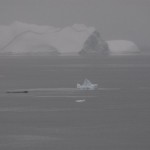
and the sea conditions were pretty good (much nicer than yesterday’s tag recovery).
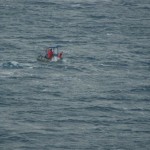
Visibility wasn’t very good given snow, fog, and overcast skies, but we put the prey-mapping boat in the water and started following the tag boat. For most of the time following the tag boat we kept our distance (so as not to interfere with their tracking of the whales to be tagged), but they left a nice trail in the slushy ice for us to follow.
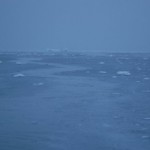
Despite the less than ideal conditions, there was enough light to see some pretty icebergs and an island (it was actually difficult for us to determine if it was an island or a very large grounded iceberg).
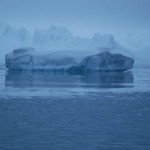
For most of the acoustic survey, there wasn’t much in the water column in terms of krill. However, there were whales in the area and they appeared to be traveling at a pretty good speed. Towards the end of our survey effort (which is usually around 3:30 or 4pm (local time) as it gets dark around then), the whales seemed to slow down and/or started to spend more time in one particular spot. To my non-whale-trained eye, they also seemed to be diving. Our echosounder showed some interesting data when we traveled over a small sill (elevation in the bottom) and came into a deep part of the bay. The entire bottom of the bay was filled with scatterers (krill) and I think it’s likely that the tagged whale data that we collected today (and during tonight) will show the animal diving down to feed on this layer.
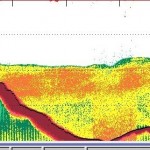
The image above comes from our 120 kHz echosounder. The vertical axis is depth in meters and the horizontal axis shows about 20 minutes of data (or about a 1000 pings from our instrument). The dark red/brown region with the thin black line is the bottom of the ocean. And you can imagine that our boat is traveling across the top of the echogram and as we travel each ping shows us what is happening underneath the boat. As we come over the sill (at about 200 m depth on the left hand side), you can see scattering (the orange/yellow regions) which are likely from krill. As we continued across the bay, the sea floor got deeper (down to about 400 m) and the krill layer extended from 200 m to the bottom. That’s an incredibly thick layer of krill (essentially two football fields stacked end-on-end!) so its not surprising that whales might want to hang around this area and are probably feeding quite well. We’ll know more tomorrow when we recover the tag (that Andrew and the tracking team are following throughout the night) and look at the dive profiles for this animal.
We weren’t out on the water very long today (only about 3 hours) but it’s extremely fortunate that we were able to get out there and tag an animal and get this prey information as I think it’ll be a very interesting data set to analyze.
And for all of us in the small boats today (Dan, Pat, Greg, Kelley, Ann, Allison, Ari): don’t worry mom(s), we’re back on the big ship safe and sound.
Joe

Whales
Any good mom would be worried if her child drives aorund these magnificent and great animals in a 6 meters long inflatable boat. If it weren’t for you guys out there we wouldn’t know so much about whales today as we do. Great work.